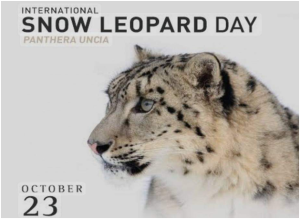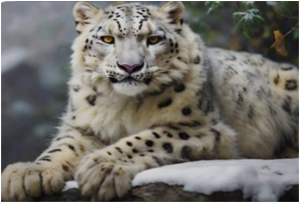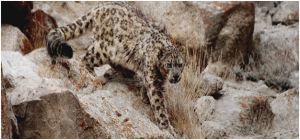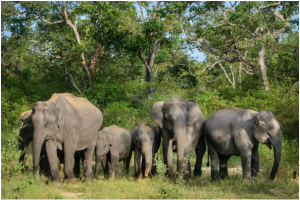
BY DR. RAVINDER PALL SAINI,
INDIAN FOREST SERVICE ( RETIRED),
MEMBER, BOARD OF ADMINISTRATION,
FOREST RESEARCH UNIVERSITY,
DEHRADUN.
DEHRADUN, 23 OCTOBER 2024;
The theme for International Snow Leopard Day 2024 is “Safeguarding Snow Leopard Habitats for Future Generations.”
This theme emphasizes the critical importance of protecting the natural habitats of snow leopards to ensure their survival and the health of mountain ecosystems.
It is celebrated on October 23rd each year to raise awareness about the conservation of snow leopards and their endangered status.

This special day aims to highlight the importance of protecting this elusive and majestic big cat, which is native to the high mountain ranges of Central and South Asia.
Snow leopards are threatened by various factors, including habitat loss, poaching, and retaliatory killings. International Snow Leopard Day serves as a platform to promote efforts to conserve their natural habitats, mitigate human-wildlife conflicts, and ensure the long-term survival of this iconic species.

History of International Snow Leopard Day
International Snow Leopard Day was established to raise awareness about the conservation challenges facing snow leopards and to highlight the need for global efforts to protect this endangered species and its fragile mountain habitats.
The day came into being with the adoption of the Bishkek Declaration by 12 countries on the conservation of snow leopards.
Efforts to protect snow leopards gained momentum in the late 20th century, with the formation of various conservation organizations, international initiatives, and governmental commitments aimed at preserving the species and its unique alpine ecosystems. The increasing recognition of the critical role played by snow leopards in maintaining ecological balance and biodiversity in their habitat regions has contributed to the designation of International Snow Leopard Day as a platform to raise public awareness and promote conservation action.
Conservation groups, wildlife organizations, and governments in snow leopard range countries have played a significant role in advocating for the establishment of International Snow Leopard Day, organizing awareness campaigns, community engagement programs, and conservation projects aimed at safeguarding the future of this iconic and endangered big cat species.

The theme of International Snow Leopard Day 2024:
The theme for International Snow Leopard Day 2024 is “Safeguarding Snow Leopard Habitats for Future Generations.” This theme emphasizes the critical importance of protecting the natural habitats of snow leopards to ensure their survival and the health of mountain ecosystems.
Significance of International Snow Leopard Day:
International Snow Leopard Day holds significant significance in the global effort to raise awareness and promote conservation initiatives aimed at protecting the endangered snow leopard species and its fragile mountain ecosystems. Some key points highlighting the significance of this day include:
Raising Awareness:
International Snow Leopard Day serves as a platform to raise public awareness about the conservation challenges facing snow leopards, emphasizing the importance of protecting this iconic species and its unique high-altitude habitat.
Promoting Conservation Efforts:
The observance of this day highlights the critical need for global conservation efforts, including habitat protection, anti-poaching measures, and community-based initiatives, to safeguard the long-term survival of snow leopards and ensure the ecological balance of their mountain ecosystems.
Fostering Community Engagement:
International Snow Leopard Day encourages community engagement and participation in conservation activities, promoting a collaborative approach among local communities, conservation organizations, and governments to address human-wildlife conflicts and promote sustainable practices that support snow leopard conservation.

Encouraging Research and Monitoring:
The significance of International Snow Leopard Day extends to promoting research, monitoring, and scientific studies focused on understanding snow leopard behavior, habitat requirements, and population dynamics to inform effective conservation strategies and management plans.
Advocating Policy Changes:
The observance of International Snow Leopard Day provides an opportunity to advocate for policy changes and international cooperation in snow leopard range countries, emphasizing the importance of adopting measures that protect the species and its habitats while addressing the socio-economic needs of local communities.
Promoting Biodiversity Conservation:
International Snow Leopard Day emphasizes the broader significance of biodiversity conservation and the interconnectedness of ecosystems, highlighting the role of snow leopards as flagship species in promoting the conservation of mountain landscapes and the preservation of biodiversity hotspots.
About Snow Leopard:
The snow leopard (Panthera uncia) is a large cat species native to the mountain ranges of Central and South Asia, including the Himalayas, the Hindu Kush, and the Altai mountains. Known for its distinctive white-to-grey fur with black spots, the snow leopard is well adapted to the cold, rugged terrain of its high-altitude habitat.
Here are some key characteristics and facts about snow leopards:
Physical Characteristics: Snow leopards have a thick coat of fur that helps them survive the harsh, cold climates of their habitat. Their long and powerful tails aid in balancing on rocky terrain, and their wide, fur-covered paws act as natural snowshoes, allowing them to navigate through deep snow.
Habitat: Snow leopards typically inhabit alpine and subalpine zones at elevations ranging from 3,000 to 4,500 meters (9,800 to 14,800 feet). They are found in 12 countries across Central and South Asia, including Afghanistan, Bhutan, China, India, Kazakhstan, Nepal, Pakistan, Russia, and others.

Behaviour: Snow leopards are solitary and elusive creatures, mainly active during dawn and dusk. They are skilled hunters, preying on blue sheep, ibex, marmots, and other small mammals found in their habitat. Their elusive nature makes them challenging to study and observe in the wild.
Conservation Status:
Snow leopards are listed as “Vulnerable” on the International Union for Conservation of Nature (IUCN) Red List of Threatened Species. The main threats to their survival include poaching, habitat loss, retaliatory killings, and climate change-induced impacts on their fragile mountain ecosystems.
Conservation Efforts:
Conservation organizations and governments are working to protect snow leopards and their habitats through various initiatives, such as anti-poaching measures, community-based conservation programs, and the establishment of protected areas. These efforts aim to mitigate human-wildlife conflicts and promote sustainable practices that ensure the long-term survival of this endangered species.
Snow leopards play a crucial role in maintaining the ecological balance of their high-altitude ecosystems, making their conservation a critical priority for preserving biodiversity and ensuring the health of mountain landscapes in Central and South Asia.
Conservation efforts:
As per reports, India is home to about 450-500 snow leopards which can be spotted in the upper Himalayan regions of the country.
India has been conserving snow leopards and their habitats through the Project Snow Leopard (PSL).
India has also been part of the Global Snow Leopard and Ecosystem Protection (GSLEP) Programme since 2013.
For conservation, India has identified three large landscapes, namely, Hemis-Spiti across Ladakh and Himachal Pradesh; Nanda Devi – Gangotri in Uttarakhand; and Khangchendzonga- – Tawang across Sikkim and Arunachal Pradesh.
Snow Leopard is on the list of 22 critically endangered species for the recovery programme of the Ministry of Environment Forest & Climate Change.
SECURE Himalaya:
Global Environment Facility (GEF)-United Nations Development Programme (UNDP) funded the project on conservation of high-altitude biodiversity and reducing the dependency of local communities on the natural ecosystem. This project is now operational in four snow leopard range states, namely, Jammu and Kashmir, Himachal Pradesh, Uttarakhand, and Sikkim.
How to Observe International Snow Leopard Day:
Observing International Snow Leopard Day provides an opportunity to raise awareness, promote conservation efforts, and engage in activities that support the protection of snow leopards and their fragile mountain habitats. Here are some meaningful ways to observe this day:
Educational Programs: Organize educational programs, workshops, and seminars to raise awareness about snow leopard conservation, emphasizing the importance of preserving their habitats and the need for sustainable practices that promote coexistence between humans and wildlife.
Community Outreach: Engage with local communities in snow leopard range countries to promote community-based conservation initiatives, foster dialogue on human-wildlife conflict mitigation, and encourage the adoption of sustainable livelihood practices that support both conservation and local livelihoods.
Fundraising Campaigns:
Launch fundraising campaigns and initiatives to support snow leopard conservation projects, including habitat protection, anti-poaching efforts, and community development programs that promote the long-term well-being of snow leopards and their ecosystems.
Awareness Campaigns: Conduct awareness campaigns through various media channels, including social media, television, and radio, to disseminate information about the importance of snow leopard conservation, highlighting the unique ecological role played by snow leopards in maintaining biodiversity in high-altitude habitats.
Nature Walks and Eco-Tours: Organize nature walks, eco-tours, and wildlife viewing activities in snow leopard habitat regions, providing opportunities for participants to appreciate the beauty of these landscapes and gain a deeper understanding of the importance of preserving these delicate ecosystems.
Advocacy and Policy Initiatives: Advocate for policy changes and international cooperation to strengthen conservation efforts for snow leopards, emphasizing the need for effective legislative measures, cross-border collaborations, and sustainable management practices that ensure the long-term survival of this endangered species.
Partnerships and Collaborations: Collaborate with conservation organizations, wildlife institutions, and governmental agencies to foster partnerships and collaborations that support snow leopard conservation, promoting a united and coordinated approach to addressing the conservation challenges facing this iconic species.
International Snow Leopard Day Observation Dates:
International Snow Leopard Day is celebrated on October 23rd each year to raise awareness about the conservation of snow leopards and their endangered status.

Advertisement:






























Add Comment